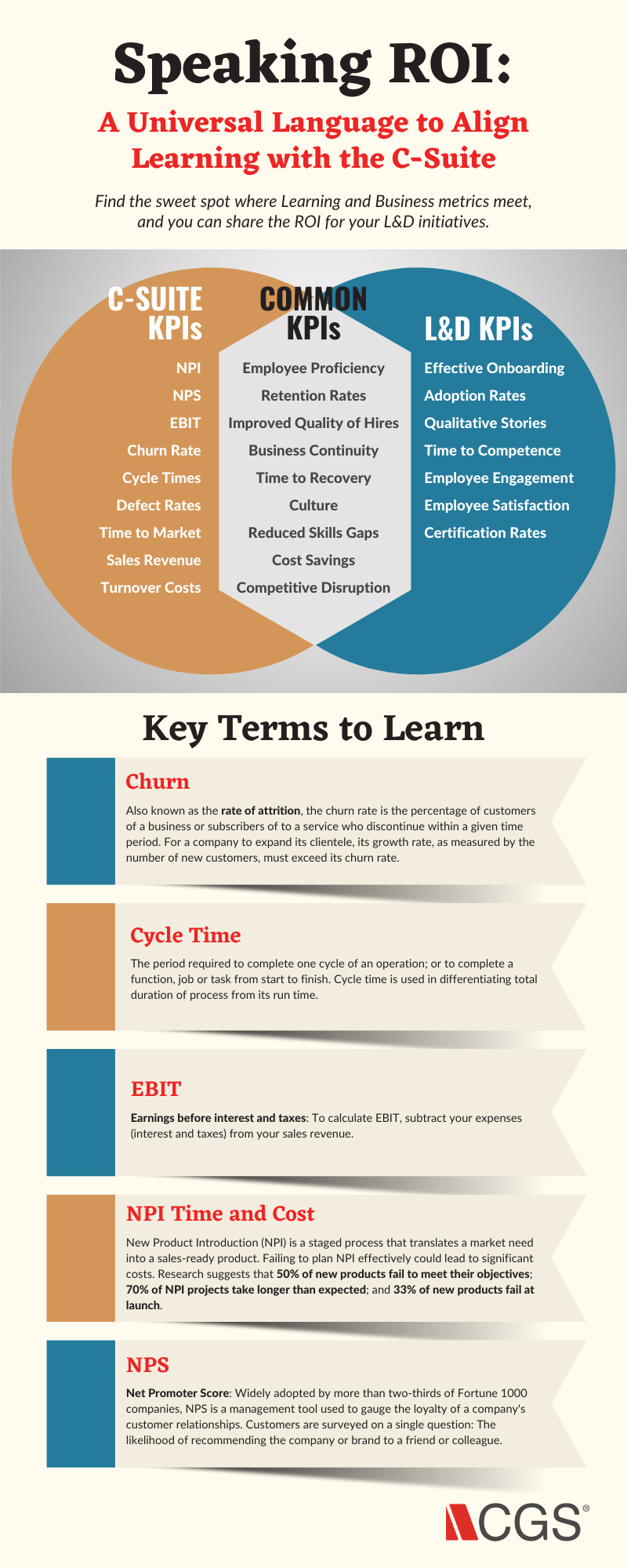Topics
Speaking ROI: A Universal Language to Align Learning with the C-Suite

Many learning directors and managers have ROI on their to-do list, but it can seem like an uphill battle to have regular KPI conversations with the C-suite. The good news is that we’re on a mission to help learning leaders navigate the issue of ROI. Leveraging our insights into the best practice programs and key metrics built into client projects serving more than 1.4 million learners across the globe, we’re launching a three-part blog series on Measuring What Matters in L&D. Part 1 offered 10 learning metrics to live by, and part 2 covered 5 metrics that matter to the C-suite. This article, including the infographic below, is a primer to speaking ROI, a language to align L&D with other lines of business.
There’s a reason why businesses continue to invest in learning and talent management; executives reasonably assume that these programs will deliver important strategic benefits across global operations. Historically, talent management was often run as a separate pillar of the business with its own language, set of metrics and schedules. Its ROI was not measured in business terms.
But this has changed in recent years. In Chief Learning Officer’s Learning State of the Industry survey, 26 percent of respondents said they currently measure formal ROI for learning, 24 percent said they plan to begin doing so in the next 12 months and an additional 13 percent plan to within the next 12 to 24 months. However, only 24 percent said they report these ROI measurements to company executives.
Having a better understanding of how much every dollar invested in learning is bringing back to the business is key to having a say on the organization’s future investments. In turn, this also improves L&D departments’ influence in leading organizational transformations. Clearly identifying ROI also allows teams to reinforce the programs and initiatives that are getting the most bang for the buck and to revisit those that are underperforming. Measuring the right KPIs increases the impact of L&D.
This infographic seeks to break down silos by comparing and contrasting business and learning metrics, as well as providing the terminology to speak the same language as line of business leaders. Let’s dive in.

Working, and succeeding, in the next normal requires strong talent development, including upskilling and reskilling. This requires a strong L&D function in organizations. And L&D will be in the driver’s seat for many of these transformations. In LinkedIn’s Workplace Learning 2021 report, 66 percent of Learning professionals agreed that L&D is focused on rebuilding or reshaping their organization. Some 64 percent agreed that L&D programs shifted from a “nice to have” to a “need to have” in 2021. Upskilling and reskilling was the top priority for 59 percent of respondents.
In the same survey, 63 percent of professionals said that L&D had a seat at the C-suite table. Make the most of your seat and this momentum. Find where business and learning KPIs and ROI merge, and then report on these measurements. It’s time to celebrate L&D successes and make improvements where needed.
Unsure where to start? Wherever you are in your L&D journey, the right partner can help you build customized content, track and manage programs, analyze outcomes and much more. Reach out to one of our learning strategists to learn more.

